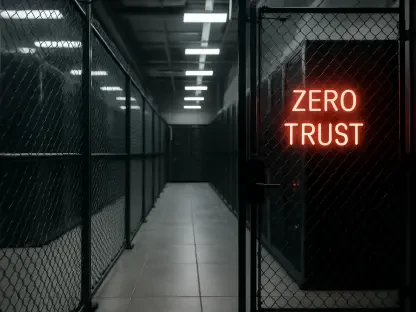In an era where cyber threats are evolving at an unprecedented pace and businesses are racing to secure their cloud-based operations, Netskope emerges as a key player with its Secure Access Service Edge (SASE) platform, poised for a landmark initial public offering on Nasdaq later this year. This event arrives at a critical juncture for the cybersecurity industry, as enterprises grapple with the complexities of digital transformation and the urgent need for robust, unified security solutions. Netskope’s promise of integrating networking and security into a single framework has captured attention, especially with an impressive annual recurring revenue of $707 million reported by mid-2025. Yet, the question lingers: can this IPO mark a turning point for cloud security, or will Netskope struggle to stand out in an intensely competitive market? The stakes are high as investors and industry watchers weigh the company’s growth, innovation, and financial hurdles against the backdrop of a rapidly shifting landscape.
Netskope’s Market Position and Growth Metrics
Revenue Surge and Market Capture
Netskope’s financial trajectory paints a compelling picture of its foothold in the cloud security arena, with annual recurring revenue reaching $707 million by mid-2025, driven by a striking 33% year-over-year growth. This figure not only reflects the company’s ability to attract and retain clients but also positions it ahead of the SASE market’s projected compound annual growth rate of 27.2% through 2030. A significant driver behind this success is Netskope’s strategic focus on Fortune 500 enterprises, which prioritize comprehensive security solutions amid their cloud migrations. The high win rates—exceeding 80% in proof-of-concept trials—suggest that once potential customers experience the platform’s capabilities, they are highly likely to commit, further solidifying Netskope’s market capture. This momentum underscores a growing trust in the company’s ability to address complex security needs in a digital-first environment, setting a strong foundation for its upcoming public debut.
Beyond the raw numbers, Netskope’s revenue growth signals a deeper resonance with the evolving demands of large-scale businesses navigating hybrid work models and expansive cloud ecosystems. The potential net dollar retention rates, estimated to hover between the high 90s and 120%, point to strong customer loyalty and upsell opportunities, even if exact figures remain under wraps. This stickiness is particularly notable in a sector where switching costs can be prohibitive, and enterprises often seek long-term partners rather than short-term fixes. By targeting top-tier clients with a top-down sales approach, Netskope has carved out a niche that not only boosts its revenue metrics but also enhances its credibility as a leader in the SASE space. As the IPO approaches, these growth indicators will likely serve as a key metric for investors assessing the company’s capacity to sustain its upward trajectory in a competitive field.
Industry Trends Fueling Success
Netskope’s rise aligns seamlessly with broader industry shifts, particularly the accelerating trend of cloud migration that has pushed enterprises to rethink traditional security models. As businesses increasingly adopt cloud-first strategies, the demand for solutions that secure data across distributed environments has surged, and Netskope’s SASE platform addresses this by integrating security and networking into a cohesive offering. Additionally, the embrace of zero-trust architectures—where no user or device is inherently trusted—has become a cornerstone of modern cybersecurity, and Netskope’s focus on this paradigm positions it at the forefront of industry best practices. This alignment with secular trends not only validates the company’s strategic direction but also highlights its relevance in a market where adaptability is paramount.
Another pivotal trend propelling Netskope’s success is the industry’s pivot toward single-vendor SASE platforms, with forecasts suggesting that 50% of deployments will favor such solutions by 2028. The complexity of managing multiple vendors for security and networking functions has driven enterprises to seek streamlined, unified systems, and Netskope’s integrated approach directly addresses this pain point. By offering a comprehensive platform that reduces operational overhead, the company is well-placed to capture a significant share of this transitioning market. This strategic fit with emerging preferences underscores Netskope’s potential to not just participate in but actively shape the future of cloud security, especially as it steps into the public market spotlight with heightened visibility.
Technological Edge and Innovation
Unified Platform Advantage
At the heart of Netskope’s appeal lies the Netskope One platform, a unified SASE solution that integrates critical security functions like Secure Web Gateway, Zero Trust Network Access, and Firewall-as-a-Service into a single architecture. This approach contrasts sharply with the modular offerings of some competitors, where disparate components can lead to integration challenges and increased complexity for end users. Netskope’s streamlined design not only simplifies deployment for enterprises but also enhances performance through consistent policy enforcement across cloud and on-premises environments. The platform’s ability to deliver low-latency access via the NewEdge infrastructure further amplifies its value, catering to the needs of businesses reliant on real-time cloud applications. This technical cohesion is a significant differentiator in a fragmented market.
Beyond its architectural strengths, the Netskope One platform addresses a critical need for scalability as enterprises expand their digital footprints. The seamless integration of security and networking capabilities allows businesses to adapt to growing workloads without sacrificing protection or performance, a crucial factor for large organizations managing complex IT ecosystems. Unlike competitors who may require additional tools or partnerships to achieve similar coverage, Netskope’s all-in-one framework reduces vendor sprawl, cutting down on both costs and potential vulnerabilities. This advantage is particularly resonant as companies prioritize efficiency in their security investments. As Netskope prepares for its public debut, this unified approach could serve as a compelling selling point for investors seeking exposure to innovative, future-ready solutions in the cybersecurity space.
AI as a Differentiator
Netskope’s commitment to cutting-edge technology is vividly illustrated by SkopeAI, an AI-driven tool adopted by 30% of its 3,400 customers for automated threat detection and response. In an era where cyber threats are becoming increasingly sophisticated, the ability to identify and mitigate risks in real time is invaluable, and SkopeAI leverages machine learning to analyze patterns and predict potential breaches before they escalate. This capability not only enhances the security posture of Netskope’s clients but also reduces the burden on IT teams by automating routine tasks like policy optimization. By embedding such intelligence into its platform, Netskope demonstrates a forward-thinking approach that resonates with enterprises facing an ever-evolving threat landscape.
The broader demand for AI-driven security solutions further amplifies the significance of Netskope’s investment in tools like SkopeAI, as businesses across sectors recognize the limitations of traditional, reactive defenses. With AI-powered attacks on the rise, the need for adaptive, proactive systems has never been greater, and Netskope’s technology positions it as a leader in meeting this challenge. The integration of such capabilities into its SASE platform also creates a competitive edge, distinguishing it from rivals who may lag in adopting intelligent security measures. For companies prioritizing innovation in their vendor selection, Netskope’s AI focus offers a compelling reason to choose its services. As the cybersecurity field continues to prioritize automation, this technological strength could prove pivotal in sustaining Netskope’s market relevance post-IPO.
Financial Challenges and Investor Concerns
Profitability Struggles
Despite its impressive growth, Netskope faces significant financial hurdles, with fiscal losses surpassing $350 million for the current year, even as they narrowed by 18% in the first half. This persistent unprofitability reflects the high costs of scaling operations and maintaining a competitive edge in a fast-moving industry. A major contributor to these deficits is the company’s substantial investment in research and development, which exceeds the industry average of 15% of revenue. While this spending fuels critical advancements in areas like post-quantum cryptography and AI agent security, it delays the timeline to break even. For a company on the cusp of going public, striking a balance between innovation and fiscal discipline remains a pressing challenge that could influence investor confidence.
The implications of Netskope’s financial performance extend beyond mere numbers, shaping perceptions of its long-term sustainability in a volatile economic climate. High R&D expenditures, while necessary for staying ahead of cyber threats, raise questions about whether such levels of investment can be maintained without compromising other operational areas. Investors are likely to scrutinize the company’s ability to manage costs while continuing to drive growth, especially in a market where profitability often serves as a benchmark for maturity. The narrowing of losses offers a glimmer of hope, suggesting improved cost management, but the path to consistent positive earnings appears distant. As Netskope transitions to a public entity, demonstrating progress on this front will be critical to maintaining market trust.
Valuation and Market Sentiment
Netskope’s implied IPO valuation of $5.12 billion, notably lower than its private valuation peak of $7.5 billion a few years ago, reflects cautious market sentiment about its near-term financial health. This discounted entry point could present an attractive opportunity for investors, particularly when compared to peers like Zscaler, which trades at a price-to-sales ratio of 17.5, and Palo Alto Networks at 13.7. However, the reduced valuation also signals underlying skepticism about the company’s ability to achieve profitability soon, especially amid ongoing losses. For those considering a stake in Netskope, this valuation dynamic introduces both potential upside and inherent risk, depending on how the company executes post-IPO.
Market sentiment around Netskope’s financial outlook is further complicated by broader economic uncertainties that could impact investor appetite for high-growth, unprofitable tech firms. While the lower valuation may appeal to long-term stakeholders betting on future gains, short-term volatility remains a concern, particularly if quarterly results fail to show sustained improvement in loss reduction. The IPO’s framing as a strategic move to enhance brand visibility rather than a desperate need for capital adds a layer of intrigue, suggesting confidence in existing cash reserves. Nevertheless, the cautious optimism among analysts highlights the need for Netskope to deliver concrete evidence of financial progress. How the market ultimately prices this offering will serve as a litmus test for broader confidence in the SASE sector’s growth narrative.
Competitive Landscape and Risks
Standing Out Among Giants
In a crowded cybersecurity market, Netskope distinguishes itself through a combination of integrated architecture and technical prowess, particularly when compared to established players like Zscaler and Palo Alto Networks. While Zscaler benefits from a strong public market presence and a modular SASE approach, Netskope’s unified Netskope One platform offers a more cohesive experience, reducing complexity for clients. Similarly, Palo Alto Networks’ extensive resources and ecosystem partnerships provide a broad reach, yet Netskope counters with specialized strengths like the NewEdge infrastructure, which ensures low-latency access for cloud and AI-driven applications. These technical advantages position Netskope as a formidable contender, even against industry giants with deeper pockets.
The competitive edge Netskope holds is not merely technological but also strategic, as it targets enterprises seeking streamlined, single-vendor solutions amid a trend toward consolidation in SASE deployments. This focus allows Netskope to appeal to organizations wary of managing multiple security tools, a pain point often exploited by larger competitors with broader portfolios. However, standing out requires more than innovation; it demands consistent execution and the ability to scale without losing focus on core strengths. As Netskope prepares for its public debut, its capacity to maintain differentiation while expanding market share will be closely watched. The company’s ability to leverage its unique offerings against the backdrop of well-resourced rivals could determine its long-term standing in the industry.
External and Internal Threats
Netskope’s growth trajectory, while promising, is not immune to external pressures such as potential slowdowns in enterprise IT spending, which could dampen demand for SASE solutions. Economic uncertainty often leads businesses to tighten budgets, prioritizing essential expenditures over transformative security investments, even as cyber risks escalate. Additionally, regulatory changes—particularly around data privacy and cloud compliance—could introduce new hurdles, potentially slowing adoption rates or increasing operational costs for providers like Netskope. These macroeconomic and policy factors represent significant risks that could disrupt the company’s momentum, regardless of its internal strengths, as it steps into the public market.
Internally, Netskope must navigate the challenges of balancing aggressive innovation with financial stability, a tightrope walk complicated by fierce competition from entrenched players. The pressure to maintain high R&D spending to stay ahead of evolving threats could strain resources, especially if revenue growth does not keep pace with expectations. Moreover, any missteps in execution—such as delays in platform updates or customer service lapses—could erode trust among enterprise clients, who demand reliability in their security vendors. As Netskope faces scrutiny post-IPO, its ability to mitigate these internal risks while adapting to external headwinds will be paramount. The interplay of these threats underscores the complex environment in which the company must prove its resilience and vision.
Reflecting on Strategic Pathways
Looking back, Netskope’s journey to its IPO later this year reveals a blend of remarkable achievements and persistent challenges that shape its narrative in the cloud security realm. The company’s robust growth in annual recurring revenue and leadership in the SASE market stand as testaments to its innovative approach, while substantial financial losses highlight the steep cost of staying ahead in a cutthroat industry. Competitive pressures and external risks further complicate the path, testing Netskope’s ability to sustain its edge. For stakeholders, the focus now shifts to actionable steps: closely monitoring post-IPO quarterly results for signs of financial discipline, evaluating the company’s execution against rivals, and assessing its adaptability to market shifts. Long-term investors might consider building a position with an eye on a 5–7 year horizon, capitalizing on Netskope’s potential to redefine enterprise security if it navigates these hurdles successfully. The road ahead demands vigilance, but the opportunity to engage with a transformative player in a $17.22 billion market remains compelling.









